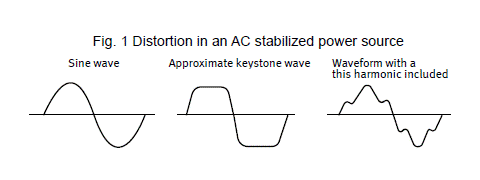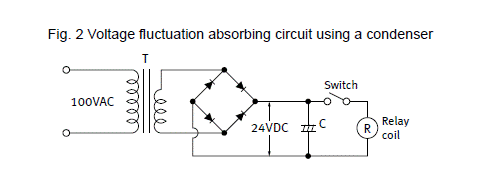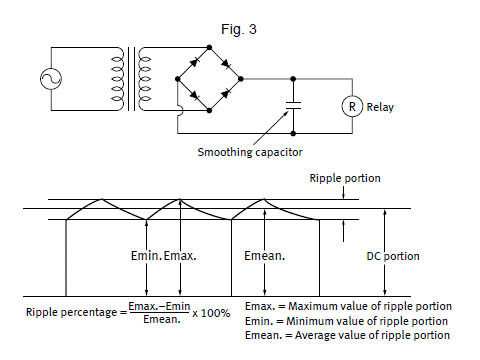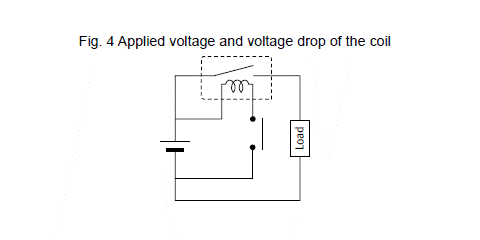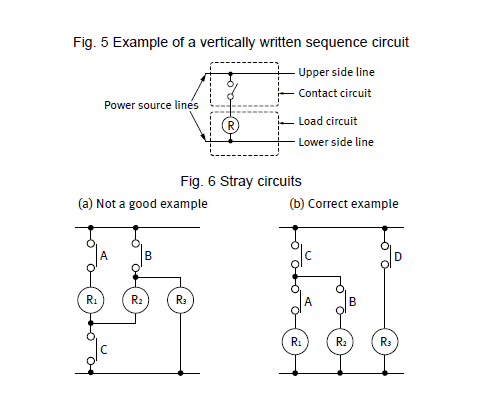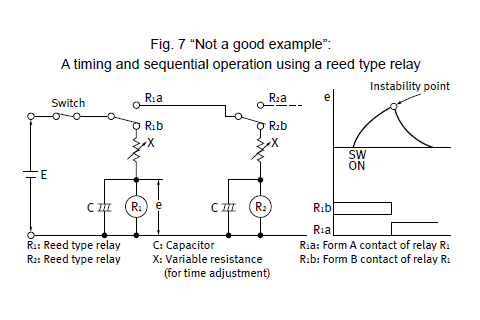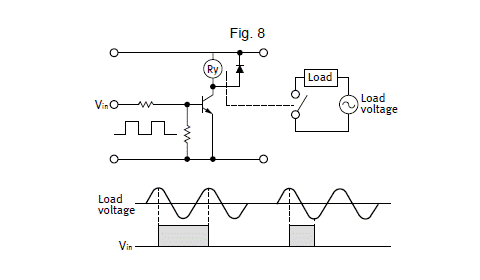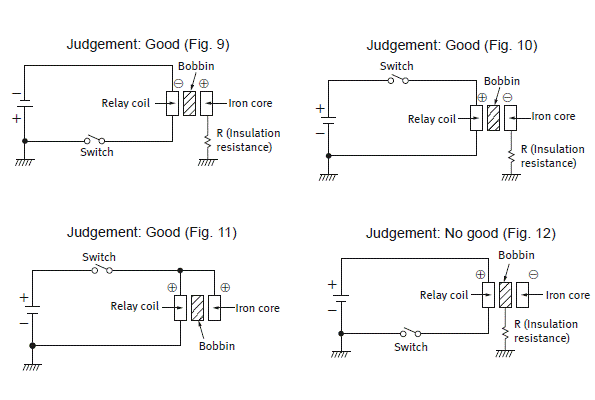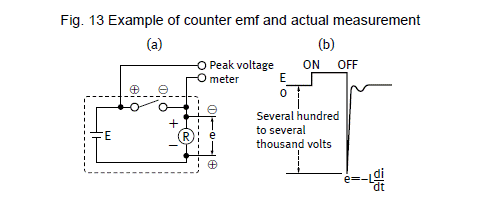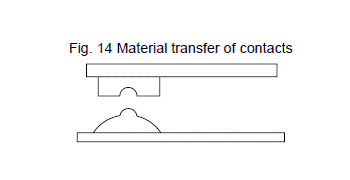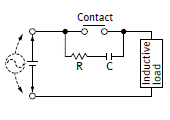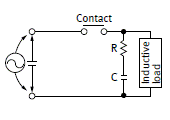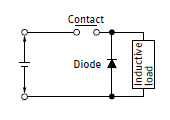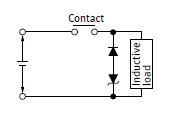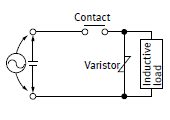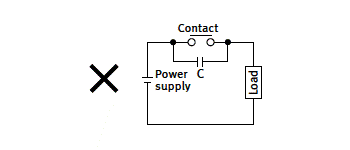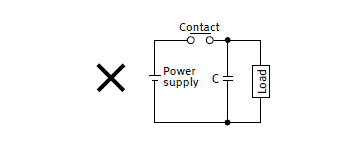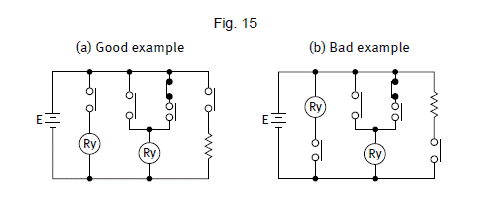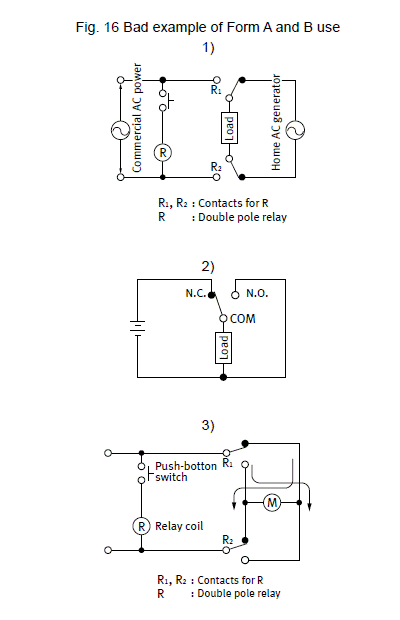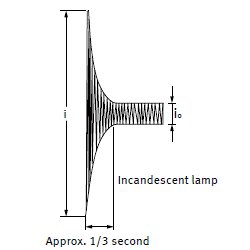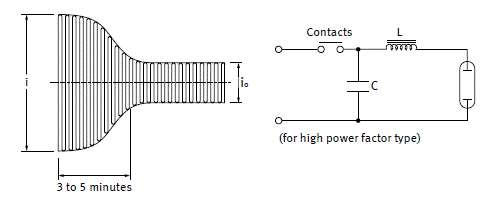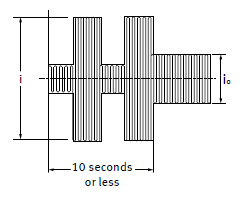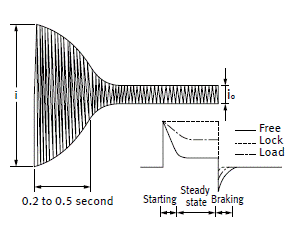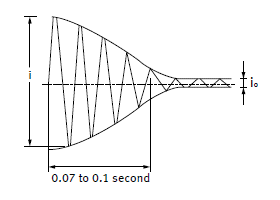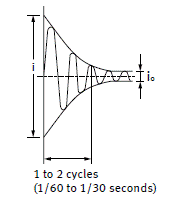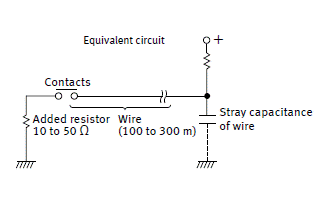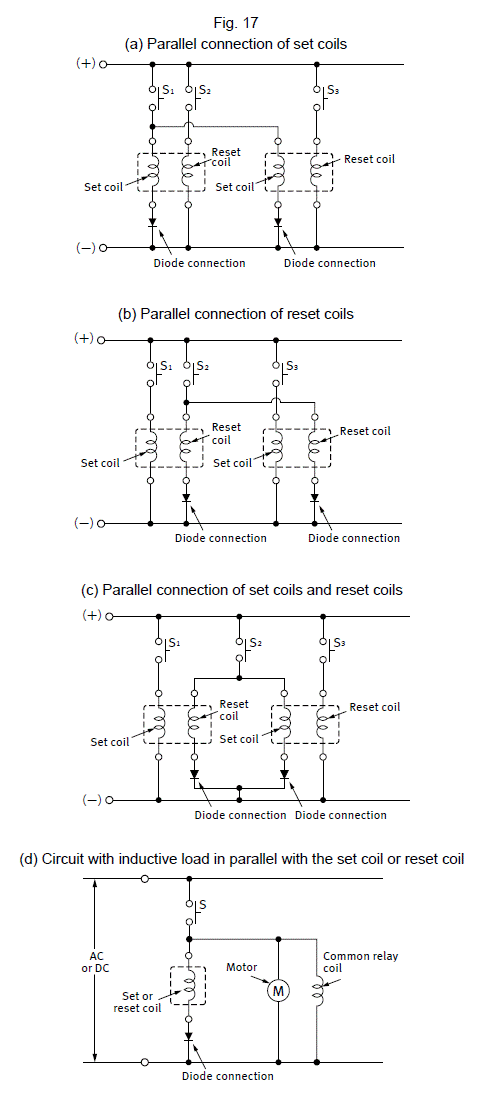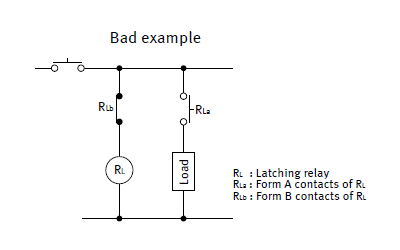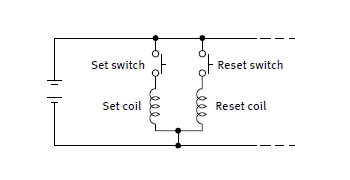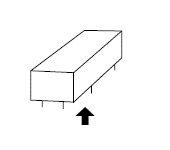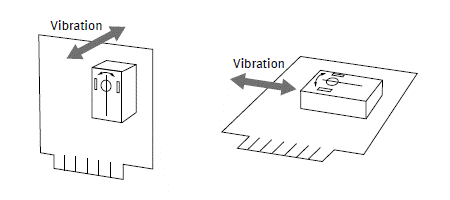| Relay Type | Terminal Nos. |
|---|
| DS | 1 Form C | - |
|---|
| 2 Form C | 15 & 16 |
|---|
| ST | * |
|---|
| SP | 2 & 4 |
|---|
1. * ST relays are constructed so that the set coil and reset coil are separated for high insulation resistance.
2. DSP, TQ, S relays are not applicable due to polarity.
Minimum Pulse Width
As a guide, make the minimum pulse width in order to set or reset a latching relay at least 5 times the set time or reset time of each product and apply a rectangular-wave rated voltage. Also, please verify operation. Please inquire if you cannot obtain a pulse width of at least 5 times the set (reset) time. Also, please inquire regarding capacitor drive.
Two Coil Latch Induction Voltage
Each coil in a 2-coil latch relay is wound with a set coil and a reset coil on the same iron cores. Accordingly, induction voltage is generated on the reverse side coil when voltage is applied and shut off to each coil. Although the amount of induction voltage is about the same as the rated relay voltage, you must be careful of the reverse bias voltage when driving transistors.
Handling Cautions for Tube Packaging
Some types of relays are supplied in tube packaging. If you remove any relays from the tube packaging, be sure to slide the stop plug at one end to hold the remaining relays firmly together so they would not move in the tube. Failing to do this may lead to the appearance and/or performance being damaged.
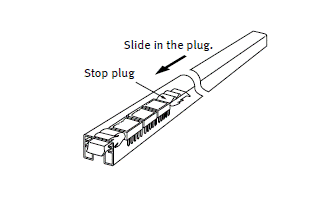
Ambient Environment
Ambient Temperature and Atmosphere
Be sure the ambient temperature at the installation does not exceed the value listed in the catalog.
Furthermore, environmentally sealed types (plastic sealed type) should be considered for applications in an atmosphere with dust, sulfur gases (SO2, H2S), or organic gases.
When connecting multiple relays or when there is heat received from other equipment, Heat dissipation may be insufficient and the ambient temperature of the relay may be exceeded. After checking the temperature in the actual device, please design the circuit with sufficient thermal margin.
Silicon Atmosphere
Silicon-based substances (silicon rubber, silicon oil, silicon-based coating material, silicon caulking compound, etc.) emit volatile silicon gas. Note that when silicon is used near relay, switching the contacts in the presence of its gas causes silicon to adhere to the contacts and may result in contact failure (in plastic sealed types, too). In this case, use a substitute that is not silicon-based.
NOx Generation
When a relay is used in an atmosphere high in humidity to switch a load which easily produces an arc, the NOx created by the arc and the water absorbed from outside the relay combine to produce nitric acid. This corrodes the internal metal parts and adversely affects operation.
Avoid use at an ambient humidity of 85% R.H. or higher (at 20°C). If use at high humidity is unavoidable, consult us.
Vibration and Shock
If a relay and magnetic switch are mounted next to each other on a single plate, the relay contacts may separate momentarily from the shock produced when the magnetic switch is operated and result in faulty operation. Countermeasures include mounting them on separate plates, using a rubber sheet to absorb the shock, and changing the direction of the shock to a perpendicular angle.
Also, if vibration is always applied to the relay, evaluate the actual operating environment.
Do not use with sockets.
Influence of External Magnetic Fields
When a magnet or permanent magnet in any other large relay, transformer, or speaker is located nearby, the relay characteristics may change and faulty operations may result. The influence depends on the strength of the magnetic field and it should be checked at theinstallation.
Usage, Storage, and Transport Conditions
During usage, storage, or transportation, avoid locations subject to direct sunlight and maintain normal temperature, humidity, and pressure conditions.
The allowable specifications for environments suitable for usage, storage, and transportation are given below.
(1) Temperature
The allowable temperature range differs for each relay, so refer to the relay’s individual specifications.
In addition, when transporting or storing relays while they are tube packaged, there are cases when the temperature may differ from the allowable range. In this situation, be sure to consult the individual specifications.with less than a 5% ripple. Also ordinarily the following must be given thought.
(2) Humidity
5 to 85% RH
The humidity range varies with the temperature.
Use within the range indicated in the graph.
(The allowable temperature depends on the relays.)
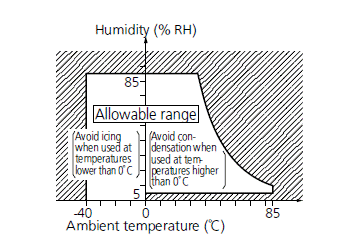
(3) Pressure
86 to 106 kPa
(4) Condensation
Condensation will occur inside the switch if there is a sudden change in ambient temperature when used in an atmosphere of high temperature and high humidity. This is particularly likely to happen when being transported by ship, so please be careful of the atmosphere when shipping. Condensation is the phenomenon whereby steam condenses to cause water droplets that adhere to the switch when an atmosphere of high temperature and humidity rapidly changes from a high to low temperature or when the switch is quickly moved from a low humidity location to one of high temperature and humidity. Please be careful because condensation can cause adverse conditions such as deterioration of insulation, coil cutoff, and rust.
(5) Icing
Condensation or other moisture may freeze on the switch when the temperatures is lower than 0°C. This may cause problems such as fixing of the movable contact, operation delay, or interference of ice between the contacts, which may interfere with contact conduction.
(6) Low temperature, low humidity
The plastic becomes brittle if the switch is exposed to a low temperature, low humidity atmosphere for long periods of time.
(7) High temperatures, high humidity
Storage for extended periods of time (including transportation periods) at high temperatures or high humidity levels or in atmospheres with organic gases or sulfide gases may cause a sulfide film or oxide film to form on the surfaces of the contacts and/or it may interfere with the functions. Check out the atmosphere in which the units are to be stored and transported.
(8) Packing format
In terms of the packing format used, make every effort to keep the effects of moisture, organic gases and sulfide gases to the absolute minimum.
(9) Storage (for signal,microwave)
Since the SMD type is sensitive to humidity it is packaged with tightly sealed anti-humidity packaging. However, when storing, please be careful of the following.
- Please use promptly once the anti-humidity pack is opened. (within 72 hours, Max. 30°C/70% R.H.).
If left with the pack open, the relay will absorb moisture which will cause thermal stress when reflow mounting and thus cause the case to expand. As a result, the seal may break.
* For RE relays, after this bag is opened, the product must be used within 24 hours. - If relays will not be used within 72 hours, please store relays in a humidity controlled desiccator or in an anti-humidity bag to which silica gel has been added.
* If the relay is to be soldered after it has been exposed to excessive humidity atmosphere, cracks and leaks can occur. Be sure to mount the relay under the required mounting conditions.
* For RE relays, after this bag is opened, the product must be used within 24 hours. - When relays (which is packaged with humidity indicator and silica gel) meeting one of below criteria, please bake (dry) before use.
(for signal)
・When the storage conditions specified in 1. are exceeded.
・When humidity indicator is in III or IV status according to judgment standard.
[How to judge]
Please check humidity indicator color and decide if baking is necessary or not.
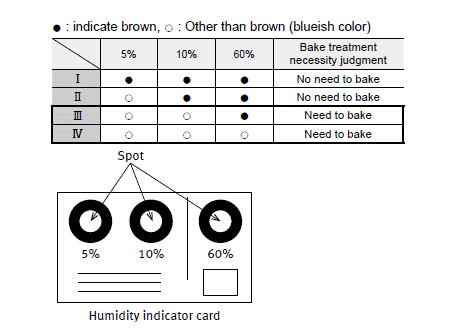
[Baking (Drying) conditions]
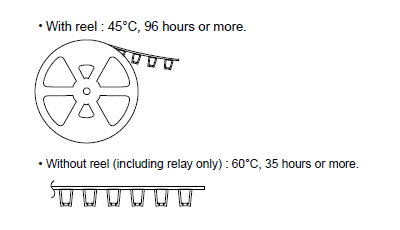
- The following cautionary label is affixed to the anti-humidity pack.
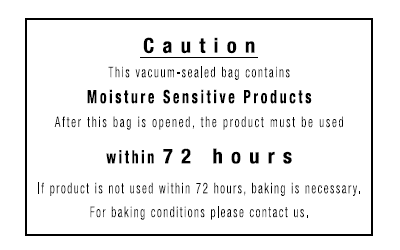
* RE Relays only
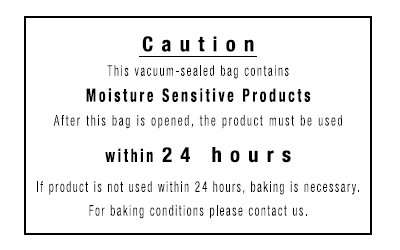
Vibration, Impact and Pressure when Shipping
When shipping, if strong vibration, impact or heavy weight is applied to a device in which a relay is installed, functional damage may occur. Therefore, please package in a way, using shock absorbing material, etc., so that the allowable range for vibration and impact is not exceeded.
Environmentally Sealed Type Relays
Sealed type relays are available. They are effective when problems arise during PC board mounting (e.g. automatic soldering and cleaning). They also, of course, feature excellent corrosion resistance. Note the cautions below regarding the features and use of environmentally sealed type relays to avoid problems when using them in applications.
Operating Environment
Plastic sealed type relays are not suited for use in environments that especially require air tightness. Although there is no problem if they are used at sea level, avoid atmospheric pressures beyond 96±10 kPa. Also avoid using them in an atmosphere containing flammable or explosive gases.
Cleaning
When cleaning a printed circuit board after soldering, we recommend using alcohol based cleaning fluids. Please avoid ultrasonic cleaning. The ultrasonic energy from this type of cleaning may cause coil line breakage and light sticking of contacts.
Mounting Considerations
